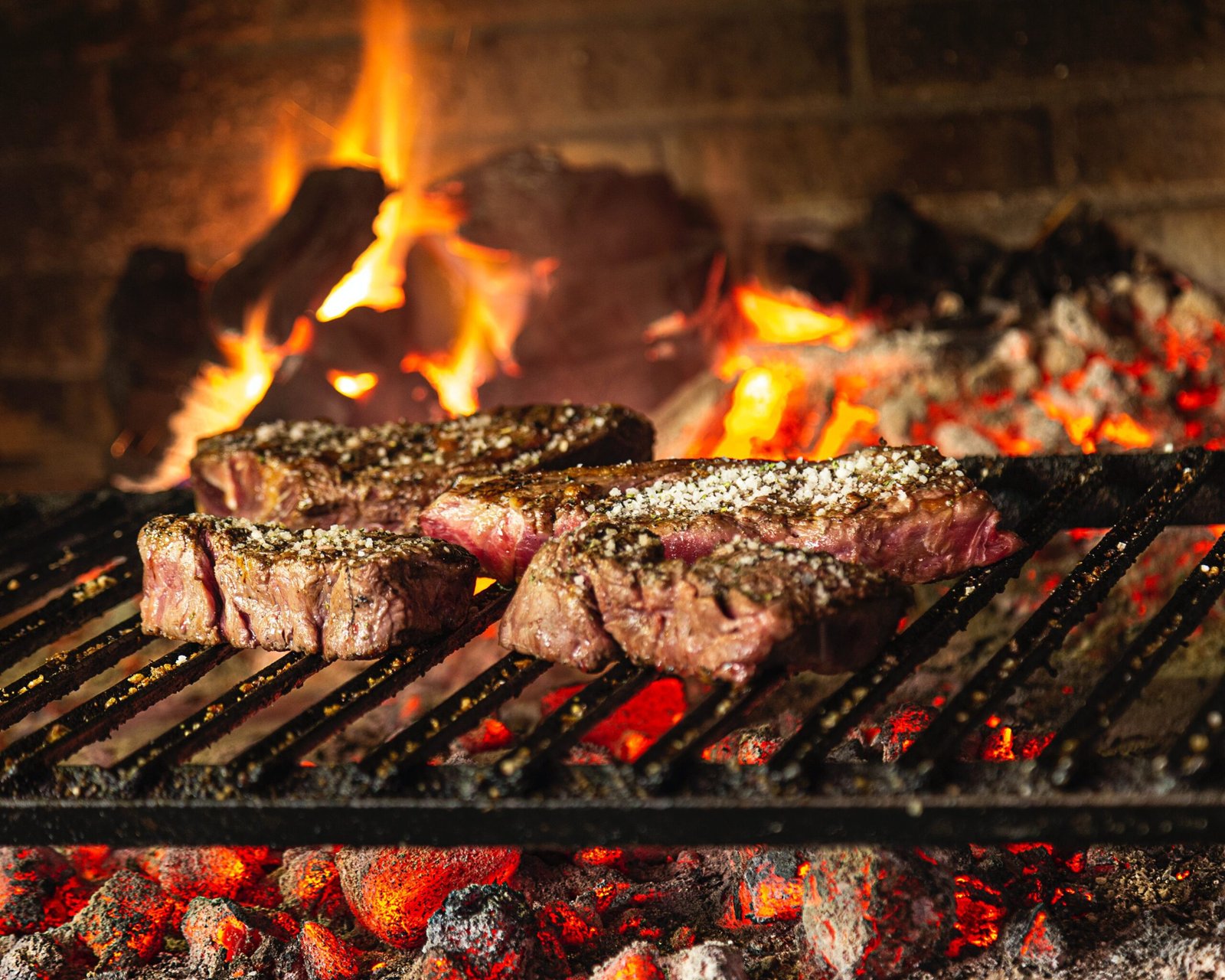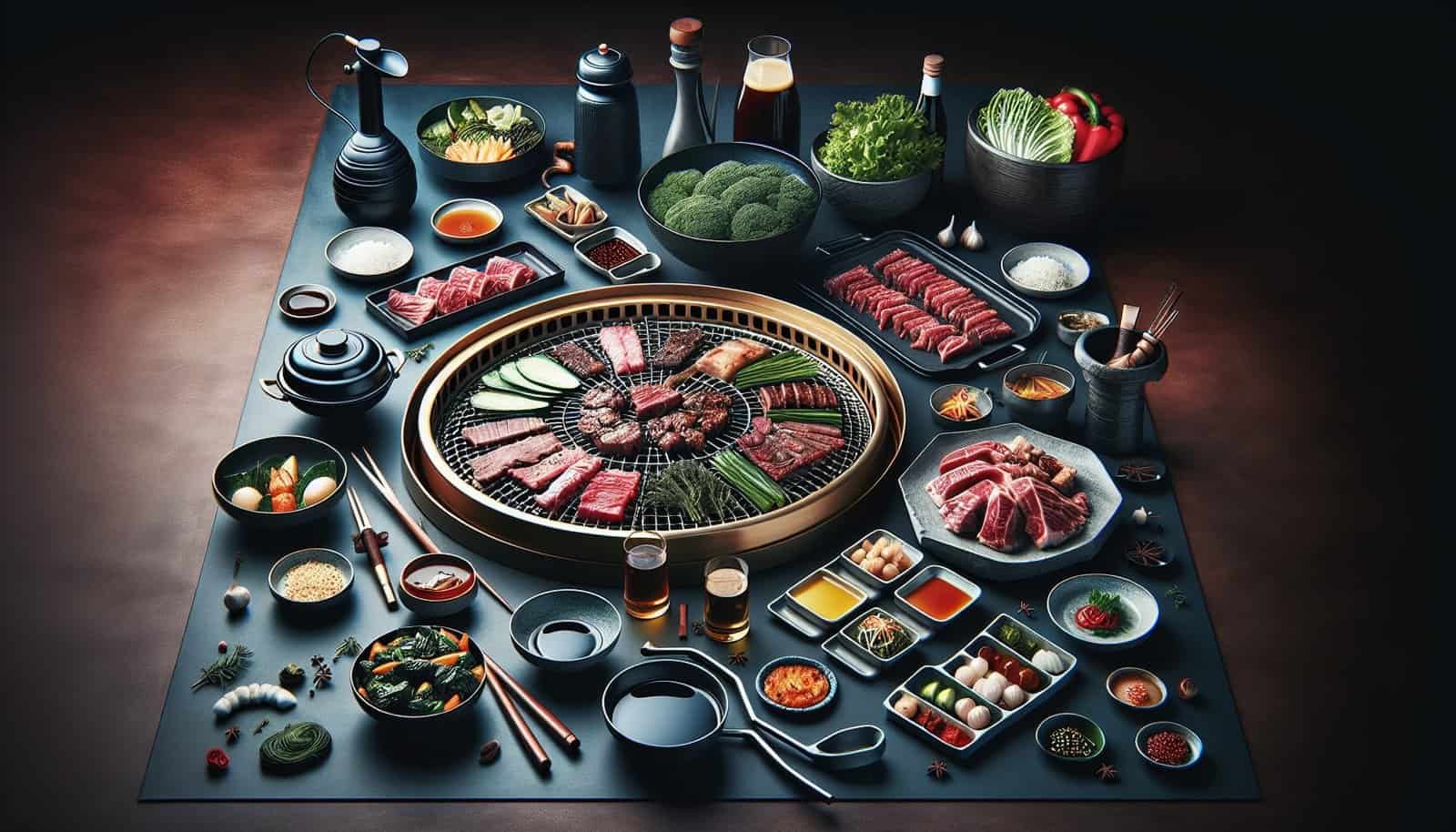Imagine indulging in the mouthwatering flavors of traditional Korean barbecue, but with a contemporary twist that awakens your taste buds. As the tantalizing aroma of grilled meats fills the air, you find yourself irresistibly drawn towards an innovative fusion of old and new. This article explores the art of giving a fresh and modern spin to the beloved Korean barbecue, infusing it with culinary creativity and techniques to elevate this timeless dining experience to new heights. Discover how the fusion of traditional and modern elements harmoniously coalesce, granting an unforgettable journey through the flavors of Korea.

Overview
Traditional Korean Barbecue
Traditional Korean barbecue, also known as “gogi-gui,” is a beloved culinary tradition that has been practiced for centuries in Korea. It involves grilling various cuts of meat, such as beef, pork, and chicken, right at the table. The vibrant flavors, communal dining experience, and interactive nature of Korean barbecue have made it a favorite dining option for locals and tourists alike.
Modernizing Traditional Cuisine
While traditional Korean barbecue holds a special place in the hearts of many, modernizing this cuisine has become a popular trend in recent years. Chefs and restaurateurs are finding innovative ways to incorporate new flavors, ingredients, techniques, and presentation styles to elevate the traditional Korean barbecue experience. By embracing fusion flavors, creative sauces, alternative proteins, interactive dining, contemporary presentation, collaborations, molecular gastronomy techniques, health-conscious approaches, and digital marketing, traditional Korean barbecue is being given a modern spin that keeps it fresh and exciting.
1. Incorporating Fusion Flavors
Blending Korean and International Ingredients
To give traditional Korean barbecue a modern twist, chefs are blending Korean ingredients with international flavors. By incorporating ingredients and spices from different cuisines, such as Mexican, Italian, or Middle Eastern, they create unique and tantalizing flavor profiles that complement the smoky and savory aspects of Korean barbecue. For example, adding a spicy gochujang-infused salsa to grilled meat or mixing kimchi with guacamole can create a fusion of flavors that surprises and delights the palate.
Experimenting with Different Cuisine Influences
In addition to blending Korean and international ingredients, chefs are also experimenting with different culinary influences to enhance the flavors of Korean barbecue. They draw inspiration from various regional cuisines within Korea itself, such as incorporating flavors from Jeju Island or Busan. Additionally, they explore techniques and ingredients from other Asian cuisines, like Japanese or Thai, to create exciting new flavor combinations. This experimentation adds depth and complexity to the traditional Korean barbecue experience, pushing boundaries and expanding the culinary horizon.
2. Creative Sauces and Marinades
Innovative Flavors and Combinations
Sauces and marinades play a crucial role in the flavor profile of Korean barbecue. To modernize this aspect of the cuisine, chefs are developing innovative sauces and marinades that bring unique flavors and combinations to the table. They experiment with ingredients like fruit juices, honey, miso, or even truffle, adding a touch of sweetness, umami, or richness to the meat. By introducing unexpected flavor combinations, they create memorable dining experiences that elevate traditional Korean barbecue to a new level.
Mixing Traditional Sauces with Unique Ingredients
While introducing new sauces and marinades, chefs also appreciate and respect the traditional flavors of Korean barbecue. They combine traditional Korean sauces, such as ssamjang or doenjang, with unique and unexpected ingredients. For example, blending traditional soybean paste with sesame oil-infused caramel creates a delightful balance of flavors. This approach pays homage to the roots of Korean barbecue while offering a modern and exciting twist.
3. Alternative Protein Options
Introducing Vegetarian and Vegan Options
In response to the growing demand for plant-based alternatives, modern Korean barbecue restaurants are incorporating vegetarian and vegan options. Beyond just grilling vegetables, chefs have gotten creative in developing plant-based alternatives that mimic the texture and taste of meat. They use ingredients like tofu, tempeh, or seitan to create mouthwatering vegetarian and vegan protein options. These alternatives allow vegetarians and vegans to enjoy the experience of Korean barbecue without sacrificing their dietary choices.
Exploring Seafood and Poultry Alternatives
Apart from vegetarian options, modern Korean barbecue also offers alternative protein choices, such as seafood and poultry. Grilling fresh shrimp, scallops, or even octopus alongside the traditional meat offerings adds a delightful variety to the dining experience. Additionally, incorporating grilled chicken or turkey into the barbecue repertoire appeals to those seeking a lighter and healthier option. By expanding the protein options, modern Korean barbecue accommodates a wider range of dietary preferences.

4. Interactive Dining Experience
Tabletop Grilling with Modern Technology
One of the most beloved aspects of traditional Korean barbecue is the interactive nature of the dining experience. Modernizing this tradition involves incorporating technology to enhance the interactive element. Some restaurants now provide individual tabletop grills that allow diners to control the heat and cooking time of their own meat, ensuring a personalized grilling experience. Interactive displays or digital menus can also supplement the dining experience, providing information about the meat cuts, sauces, marinades, and suggested pairings.
DIY Customization Stations
To further enhance the interactive experience, modern Korean barbecue restaurants are introducing DIY customization stations. These stations offer a variety of toppings, sauces, and condiments that diners can use to personalize their dishes. From pickled vegetables and kimchi to unique spice blends and flavored oils, diners can create their own flavor combinations and experiment with different ingredients. This hands-on approach allows people to tailor their meal to their preferences and fosters creativity and exploration.
5. Contemporary Presentation
Artistic Plating Techniques
In addition to flavors and techniques, modern Korean barbecue also pays attention to the visual presentation of the dishes. Chefs are embracing artistic plating techniques to create visually stunning dishes that are almost too beautiful to eat. By arranging the grilled meats and accompanying components in an aesthetically pleasing manner, they elevate the dining experience and engage the senses beyond just taste. From meticulously arranged garnishes to thoughtfully designed plate compositions, each dish becomes a work of art.
Incorporating Modern Tableware
To further enhance the contemporary presentation, modern Korean barbecue restaurants are investing in unique and modern tableware. The choices of plates, bowls, and serving utensils are carefully curated to complement the overall dining experience. Sleek and minimalist design elements, such as matte black or marble textures, are popular choices that add a touch of sophistication. Modern tableware not only serves as a canvas for the beautifully plated dishes but also contributes to the overall ambiance of the dining space.

6. Chef Collaborations and Guest Chefs
Inviting Renowned Chefs for Special Creations
A trend in modern Korean barbecue is inviting renowned chefs to collaborate on special menu items or seasonal creations. By bringing in guest chefs with diverse culinary backgrounds and expertise, modern Korean barbecue restaurants can introduce unique flavors, ingredients, and techniques to their customers. These collaborations allow for a cross-pollination of culinary ideas and result in exciting and unexpected dishes that merge traditional Korean barbecue with other culinary traditions.
Exploring Cross-Cultural Culinary Collaborations
In addition to individual chef collaborations, modern Korean barbecue restaurants are also exploring cross-cultural culinary collaborations. They team up with restaurants specializing in other cuisines, such as Japanese, Mexican, or American, to create fusion-inspired dishes that infuse Korean barbecue techniques and flavors. This exchange of culinary knowledge and experience enriches the dining scene and offers customers a taste of diverse global flavors within the traditional Korean barbecue setting.
7. Molecular Gastronomy Techniques
Using Science and Innovation in Barbecue
Molecular gastronomy techniques have found their way into the realm of Korean barbecue, adding a modern twist to this time-honored cuisine. Chefs are employing scientific principles and innovative cooking methods to transform traditional ingredients. For example, they may use liquid nitrogen to create flash-frozen bites or spherify sauces to create unique textures and bursts of flavor. By incorporating molecular gastronomy techniques, Korean barbecue becomes not only a delicious meal but also a captivating culinary experience.
Transforming Traditional Ingredients with Modern Methods
Beyond just experimental techniques, modern Korean barbecue also applies modern cooking methods to traditional ingredients. Sous vide cooking or smoking meats with unique wood chips are just a couple of examples of how modern methods are used to enhance flavors and textures. These techniques result in tender, perfectly cooked meats that retain their natural juices and flavors, taking the barbecue experience to new heights.

8. Health-Conscious Approaches
Reducing Oil and Sodium Content
As the emphasis on health-conscious dining grows, modern Korean barbecue restaurants are finding ways to reduce the oil and sodium content in their dishes. Chefs are utilizing alternative cooking methods, such as grilling on a wire mesh or using non-stick surfaces, to minimize the need for excessive oil. Additionally, they are developing low-sodium marinades and sauces that still pack a punch of flavor. By offering healthier options, modern Korean barbecue ensures that diners can indulge in this cuisine while also taking care of their well-being.
Offering Lighter Menu Options
To cater to customers who prefer lighter meals, modern Korean barbecue restaurants are expanding their menu to include lighter options. Grilled seafood, lean cuts of meat, and an increased variety of vegetable-based dishes allow people to enjoy the barbecue experience without feeling weighed down. Lighter menu options prioritize freshness, natural flavors, and nutritional balance, ensuring that everyone can find something that suits their dietary preferences and needs.
10. Social Media and Digital Marketing
Utilizing Social Platforms for Food Promotion
In the digital age, modern Korean barbecue restaurants leverage social media platforms to promote their food and engage with customers. They create attractive and mouthwatering content, including photos and videos of sizzling meats, creative dishes, and interactive dining experiences, to capture the attention of food enthusiasts. Social media platforms like Instagram, Facebook, and TikTok are used to showcase the innovative twists and unique offerings, enticing customers to visit and try the modernized Korean barbecue.
Creating Engaging Online Content
Modern Korean barbecue restaurants also create engaging online content, such as cooking tutorials, behind-the-scenes videos, and blog posts, to educate and entertain their audience. By sharing knowledge about the ingredients, cooking techniques, and cultural significance of Korean barbecue, they foster a deeper appreciation for the cuisine. Additionally, they encourage interaction and feedback from customers, creating a sense of community and building a loyal customer base.
In summary, giving a modern spin to traditional Korean barbecue involves a multifaceted approach that encompasses flavors, techniques, presentation, and engagement. By embracing fusion flavors, creative sauces, alternative proteins, interactive dining, contemporary presentation, collaborations, molecular gastronomy techniques, health-conscious approaches, and digital marketing, modern Korean barbecue offers an exciting and dynamic dining experience that honors the tradition while pushing culinary boundaries. So, whether you’re a barbecue enthusiast or a curious food lover, venture into the realm of modern Korean barbecue and embark on a journey of flavors and innovation.

